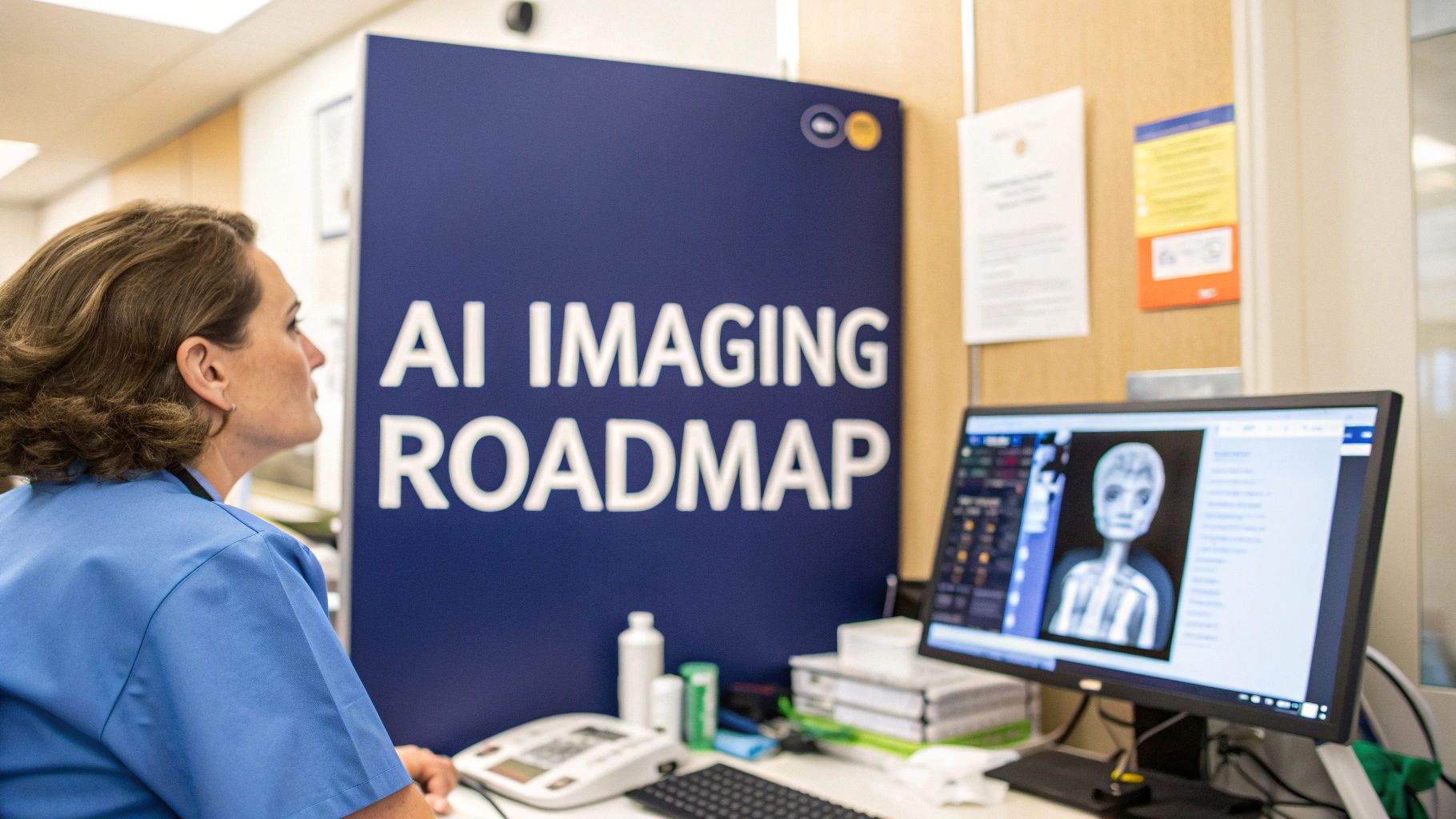When you examine the complexities of the Canadian healthcare system, it’s clear that outdated, rigid models are no longer sufficient. Think of traditional healthcare management like a city bus on a fixed route. It's predictable, but it can't react to a sudden traffic jam or a passenger who needs to get somewhere new.
Now, imagine an agile approach as a responsive ride-sharing service. It dynamically changes its route to find the fastest, most efficient way to get you to your destination. That’s the heart of Agile: a framework that puts the patient first by building flexibility right into the system.
Rethinking Patient Care with Agile Methodologies
In Canada’s healthcare landscape, traditional project management often operates in a waterfall-like manner. It’s a long, step-by-step process where one phase has to be completely finished before the next one can even start. This is structured, sure, but it’s far too slow for the unpredictable world of patient care. A year-long project to update an Electronic Health Record (EHR) system could be outdated before it even goes live.
This is exactly where agile methodologies come in as a powerful alternative.
Instead of one massive, long-term plan, agile works in cycles. It breaks down huge, complicated projects into small, manageable chunks called “sprints.” A typical sprint lasts two to four weeks and has a single goal: to deliver one specific, working piece of the larger puzzle. This constant cycle of planning, doing, and reviewing allows teams to get feedback and make adjustments on the fly.
The Shift from Process to People
The biggest change agile introduces is a move away from rigid processes and toward responsive, people-focused outcomes. It’s all about collaboration. Clinicians, IT specialists, and administrators all pull up a chair at the same table to solve problems together. This teamwork ensures that the solutions they create aren't just technically sound but are also practical for the clinic floor and efficient for the back office.
Here’s what that shift looks like in practice:
-
Iterative Progress: Forget the single "big bang" launch. Improvements are rolled out in small, steady increments, giving teams a chance to test, learn, and fine-tune as they go.
-
Continuous Feedback: Doctors and nurses, the actual end-users, give their input throughout the entire process, not just at the very end when it’s too late to make meaningful changes.
-
Adaptive Planning: The entire framework is designed to welcome change. Teams can pivot quickly when new information comes to light or when patient priorities suddenly shift.
This isn't just for software development, either. These principles can transform everything from clinical workflows to the way patients are checked in. By embracing agile, healthcare organisations can become more resilient, efficient, and truly focused on the patient.
The core promise of agile in healthcare is simple: build what is needed, learn from it quickly, and improve it constantly. It’s a commitment to evolution over static perfection, ensuring that patient care remains the central focus amidst constant change.
For organisations ready to get started, the first step is often to pick one specific pain point, like long patient wait times, and run an agile sprint to tackle it. The model is especially powerful when paired with modern technology, like the growing use of AI in medicine. For a look at broader initiatives, you can find more on reimagining healthcare innovation. This transformation sets the stage for a deeper dive into how your organisation can implement these principles for tangible results. To understand more about the synergy between modern tech and patient care, our article on the benefits of AI in the healthcare industry offers further insights.
Understanding Agile Principles in a Clinical Setting
To really get what makes agile work in healthcare, you have to look past the buzzwords and see how it plays out on the clinic floor. Forget about those massive, rigid project plans that take years to deliver. Agile is all about making small, smart changes and making them happen quickly and often. It's less of a "big bang" launch and more of a constant, steady evolution.
At its heart, Agile is built on a few straightforward but powerful ideas. It values being able to adapt over blindly following a plan, which means care providers can actually respond to patient needs as they change. This approach also breaks down huge, intimidating tasks into small, doable chunks, making progress feel real and achievable from day one.
Iterative Progress Through Sprints
Let's say a hospital wants to completely rework its patient intake process. The old-school way would be a massive, year-long project, with everything riding on one giant launch at the end. An agile approach, on the other hand, chops this up into a series of short, focused work cycles called sprints.
A sprint is usually a two-week period where a team focuses on hitting one specific, small goal. For example, the first sprint might just be about digitising a single patient form. The next could focus on making the appointment scheduling tool a little easier to use.
This step-by-step method pays off in several ways:
-
Faster Value Delivery: Instead of waiting a year for any kind of improvement, the hospital sees real benefits every two weeks.
-
Reduced Risk: If one small tweak doesn't quite work, it’s a minor hiccup, not a project-killing disaster.
-
Real-Time Feedback: Clinicians can test the new digital form right away and give their feedback, which then gets baked into the very next sprint.
This structure helps build momentum and show clear wins early on, which is absolutely vital for getting buy-in from busy clinical staff who need to see that changes are actually helping, not just adding more work.
The Power of Cross-Functional Teams
Agile is all about collaboration. It breaks down the walls between departments and brings different experts together into one focused team. In a hospital, a cross-functional team might have a doctor, a nurse, an IT specialist, and an administrator all working together.
Every person brings a crucial perspective to the table. The doctor knows what’s needed clinically, the nurse sees how the workflow plays out on the front lines, the IT specialist understands what’s technically possible, and the administrator makes sure it all makes sense financially and operationally.
By working together every day, this team can spot and solve problems from all angles. What you get is a solution that doesn't just work on a technical level; it's also practical, easy to use, and genuinely makes things better for both patients and staff.
This all comes back to a patient-first mindset, as the image below shows.

Both iterative development and cross-functional teams are just different routes leading to the same destination: better patient care.
When comparing Agile to more traditional methods, the differences in flexibility and focus become incredibly clear. The traditional "Waterfall" model, common in many industries, follows a rigid, sequential path where one phase must be completed before the next begins. In healthcare, this can lead to solutions that are already outdated by the time they're implemented.
Here’s a table that breaks down the key distinctions:
Agile vs Traditional Waterfall Approach in Healthcare Projects
|
Project Aspect |
Traditional Waterfall Approach |
Agile Approach |
|---|---|---|
|
Planning |
A single, comprehensive plan is created upfront. Changes are difficult and costly. |
Planning is adaptive. A high-level vision exists, but details emerge over time. |
|
Development |
Long, linear phases (e.g., requirements, design, build, test, deploy). |
Short, iterative cycles (sprints) that include all phases of development. |
|
Feedback Loop |
Feedback is gathered only at the end of the project, often too late to make meaningful changes. |
Continuous feedback from clinicians and patients is gathered after every sprint. |
|
Risk Management |
High-risk. Major issues may not be discovered until late in the project. |
Lower-risk. Small, frequent releases allow for early detection and correction of problems. |
|
Patient Involvement |
Patients are typically only involved at the very beginning (requirements) and end (testing). |
Patients and end-users are engaged throughout the process to ensure the solution meets their needs. |
|
Flexibility |
Very rigid. The initial plan is the roadmap, and deviation is discouraged. |
Highly flexible. The team can pivot based on new learnings or changing patient needs. |
As you can see, the Agile approach is fundamentally more responsive. It's built for the dynamic and often unpredictable environment of healthcare, ensuring that projects stay relevant and deliver real value from start to finish.
Prioritising Patient Value
At the end of the day, the goal of every sprint and every team decision is to deliver more value to the patient. Agile forces teams to constantly ask, "How will this change make the patient's experience better?" This unwavering focus on the end-user is a huge shift from older models that often got bogged down in internal processes or technical specs.
This principle is put into action using a tool called the product backlog; essentially, a prioritised to-do list for the entire project. For each sprint, the team pulls the most important tasks from the top of this list, making sure they’re always working on what matters most. If this is a new concept, you can get a good handle on the fundamentals by checking out this overview of Agile project management basics.
By bringing these core ideas, like iterative progress, collaboration, and a sharp focus on patient value, into the clinical world, healthcare organisations can become far more responsive and effective. This agile foundation is key for any clinic or hospital looking to improve its daily operations or take on complex new challenges.
Getting Past Regulatory Roadblocks with Agile Sprints
Let's be honest: innovating in Canadian healthcare can feel like trying to run through a maze with your eyes closed. You’re up against a wall of strict regulations like the Personal Health Information Protection Act (PHIPA) and Health Canada compliance. While these rules are absolutely critical for keeping patients safe, they can also bring progress to a screeching halt.
The old way of doing things, long-term, waterfall project planning, treats compliance as a single, terrifying hurdle at the very end. It's a high-stakes gamble. If you miss even one detail, you could be facing catastrophic failure and a mountain of wasted costs.
But what if you could flip that on its head? An agile approach turns this challenge into a real strategic advantage. Instead of one massive, all-or-nothing effort, agile uses short, iterative cycles called sprints to build and check features against regulatory standards in small, manageable pieces. It's the difference between a final exam and a series of open-book quizzes along the way, ensuring every part of your project is secure and correct from day one.

This doesn't mean moving fast and breaking things. Far from it. Agile is about building compliant, secure, and effective solutions intelligently, right from the start. The whole point is to weave regulatory checks directly into the development process, not just staple them on as an afterthought.
Start with a Minimum Viable Product
The key to making this work is a concept called the Minimum Viable Product (MVP). Instead of trying to build a massive, feature-loaded platform all at once, an agile team concentrates on launching the simplest possible version of the product that still delivers real value and is 100% compliant.
Think of it as a basic secure messaging app for clinicians, or a simple patient portal just for viewing lab results. By launching a smaller, fully compliant product first, healthcare organizations can unlock some serious benefits:
-
Massively reduce project risk. It's far easier to ensure a handful of features meet every PHIPA requirement than it is to validate a hundred of them at the same time.
-
Get real-world feedback, fast. Clinicians and patients can start using the core product right away, giving you priceless insights to guide what you build next.
-
Prove the value to stakeholders. A successful MVP builds confidence and secures the buy-in you need for future development, making it much easier to justify further investment.
This strategy helps you sidestep the expensive rework that often sinks big projects when compliance problems are discovered way too late in the game.
Weaving Compliance into Every Sprint
The real magic happens when you embed compliance into the very fabric of each sprint. For every new feature, security assessments, privacy impact analyses, and proper documentation aren't separate phases; they're ongoing activities.
In an agile framework, compliance isn't a gate you pass through at the end; it's a guardrail that guides you safely along the entire journey.
This means every new piece of the puzzle is built with privacy and security already baked in. It makes the final regulatory approval process a whole lot smoother because your solution has been built to standard from the ground up.
If you’re curious about how software can support this, our guide to compliance management software offers a closer look at tools designed for these kinds of workflows. By tackling regulations in small, iterative cycles, healthcare organizations can finally innovate with confidence, knowing their solutions are not just functional but fundamentally safe and secure.
How Agile is Actually Changing Canadian Hospitals and Clinics
It's one thing to talk about principles, but it's another to see them in action. The real magic of Agile Healthcare solutions happens on the ground, in the busy hallways of Canadian hospitals and clinics. This isn't just theory; it’s a practical way to fix some of the most stubborn problems in patient care. When facilities adopt an agile mindset, they start seeing real, measurable improvements that make life better for everyone, patients and staff included.
Let's look at a few real-world scenarios. These stories show the powerful difference agile can make by breaking down huge problems into manageable pieces, encouraging teams to work together, and celebrating small, steady wins.

Case Study 1: Untangling the Emergency Room Bottleneck
The Problem: A major urban hospital’s emergency room was gridlocked. Patients were stuck with long, frustrating wait times, which was a health risk. The staff felt completely burnt out, trapped in a rigid system where getting information from triage to diagnostics and back was painfully slow.
The Agile Approach: Instead of trying to boil the ocean with a massive, multi-year overhaul, the hospital formed a small, cross-functional team. It had an ER doctor, a triage nurse, a lab tech, and an administrator. Their goal? Tackle one problem at a time in focused, two-week "sprints."
-
Sprint 1: The team zeroed in on the check-in process alone. They quickly found and eliminated three administrative steps that were bogging things down.
-
Sprint 2: They tested a new digital tool that pushed real-time lab results directly to the ER physicians' tablets. No more waiting for a printout.
-
Sprint 3: They rearranged the waiting area’s layout to improve patient flow and give staff better visibility.
The Result: In just six weeks, the average ER wait time dropped by a whopping 25%. Staff morale shot up because they were finally empowered to fix the things that drove them crazy. This iterative method delivered immediate results without having to shut down or disrupt the entire department.
Case Study 2: Building an EHR Module That Clinicians Actually Use
The Problem: A regional clinic needed a new feature for its Electronic Health Record (EHR) system to track patients with chronic diseases. The traditional way of building this would have meant an 18-month wait, with clinicians only getting to see the final product at the very end. The risk of building something they wouldn't use was incredibly high.
The Agile Approach: The clinic brought in a Custom Software Development Services partner who lived and breathed agile. They created a team that included developers, a project manager, and, critically, two primary care physicians and a nurse practitioner. The whole project was mapped out in a series of one-month sprints.
The goal was no longer "build the entire system." Instead, it became "deliver one valuable, working feature every month." This kept the project perfectly aligned with what the clinicians needed from day one.
The Result: A basic but functional version of the module was in the hands of clinicians in just three months. They gave instant feedback, which was baked right into the next sprint. The full, polished module was finished in under a year, 33% faster than the original timeline, and the staff loved it because they had helped build it every step of the way. As we explored in our Agile Healthcare solutions adoption guide, getting that early buy-in is absolutely essential.
Case Study 3: Solving the Staffing Puzzle in Long-Term Care
The Problem: In a long-term care facility, last-minute call-ins and staffing gaps were causing constant chaos. The scheduler was wrestling with a manual spreadsheet system that was clumsy and full of errors. Trying to fill a shift quickly was a nightmare, and it often led to understaffed floors, which put patient care at risk.
The Agile Approach: The facility decided to build a simple, dynamic scheduling tool. They started small, focusing on a Minimum Viable Product (MVP) that did just one thing: handle shift-swapping requests. This small win proved the concept worked and got everyone on board for more. This kind of iterative problem-solving is becoming more common across Canada. For example, the Toronto-based agency, Agile Healthcare Solutions, uses a similar model by keeping a pool of backup professionals ready to fill staffing gaps in GTA facilities on short notice, showing how effective this can be for maintaining stability. You can learn more about their specialized approach to healthcare staffing.
The Result: The new system cut the time it took to fill an open shift from hours down to mere minutes. Staff loved the transparency and ease of use, which gave morale a real boost. The facility could finally react to staffing changes in real time, ensuring the quality of care never dipped because of a scheduling headache.
These examples make it clear that agile isn't just corporate jargon. It's a powerful and practical way to deliver better, more efficient healthcare. To see how our team makes these kinds of transformations happen, we invite you to learn more on our about us page.
Getting Past the Common Roadblocks in Agile Adoption
Let's be honest: shifting to an agile way of working is a lot more than just swapping out old software for new tools. It’s a genuine cultural change. And while the payoff is huge, the road to get there is almost always bumpy with some predictable challenges. If you're looking to successfully bring Agile Healthcare solutions into your clinic or hospital, the key is to know what’s coming and have a solid plan to handle it.
The first thing to accept is that you'll run into resistance. That's completely normal. When your teams are used to a traditional, top-down command structure, the idea of self-organizing teams and daily check-ins can feel a bit chaotic, even threatening. This isn't a red flag; it's just a natural part of any significant change. Overcoming it takes patience, a ton of clear communication, and leaders who are visibly steering the ship.
Dealing with Cultural Pushback
The biggest hurdle you’ll likely face is simple inertia. Clinicians and admin staff are accustomed to rigid hierarchies and planning projects months or years in advance. The very idea of two-week sprints and daily stand-ups can feel like you’re trying to turn the whole world upside down. The secret is to show them the value, and fast.
One of the most effective ways to do this is with a small, focused pilot project. Instead of trying to overhaul the entire hospital at once, pick one manageable problem; something like improving the patient discharge process in a single department. By zeroing in on a real pain point, you can create a clear success story that shows everyone exactly how agile works in a practical, undeniable way.
This strategy gives you a few big wins right out of the gate:
-
It creates champions. The people on that pilot team become your best advocates, sharing their firsthand positive experiences with their colleagues.
-
It keeps disruption low. The rest of the organisation can keep running smoothly while the new approach is being tested in a controlled environment.
-
It delivers quick results. A successful pilot provides real, measurable improvements, which makes getting buy-in for a wider rollout much easier.
Managing the Steep Learning Curve
Agile comes with its own language and new roles, like Scrum Masters and Product Owners, which can feel like a lot to take in at first. The initial learning curve can be steep, so your teams will need dedicated support to get comfortable and confident. This means investing in good training upfront and having ongoing coaching is non-negotiable.
The real aim isn't just to teach people the "rules" of agile. It's about nurturing an agile mindset, a core belief in working together, always looking for ways to improve, and putting the patient first.
For example, a daily stand-up meeting shouldn’t feel like just another mandatory calendar invite. Frame it as a quick, focused huddle designed to knock down roadblocks and keep everyone on the same page. This simple shift helps stop small snags from turning into major delays. In Canada, challenges like staffing shortages and complex regulations put enormous pressure on healthcare operations. Agile gives leaders the flexibility to adapt to everything from changing standards to new cybersecurity threats that need an immediate response. You can explore the project management roadblocks healthcare leaders face to get a deeper sense of these specific pressures.
Getting Leadership on Board
Without solid, visible support from the top, any agile initiative is doomed. Leaders need to do more than just sign off on the budget; they have to become the biggest champions of the change. Their job is to communicate the vision, clear organisational hurdles out of the way, and make a point of celebrating the small victories.
To win them over, you need to speak their language and focus on the metrics that matter most to them:
-
Return on Investment (ROI): Show them the numbers. How will agile shorten project timelines and cut costs?
-
Risk Reduction: Explain how working in short, iterative cycles dramatically lowers the risk of a massive, expensive project failure.
-
Patient Outcomes: Draw a direct line from agile practices to concrete improvements in patient safety and satisfaction scores.
Getting past these hurdles is never easy, but it’s entirely possible with a smart strategy that focuses on your people, your processes, and your leadership. As our team guides organisations through these exact challenges, we've seen firsthand how a thoughtful, phased approach builds the momentum needed for real, lasting change. To learn more about our philosophy, you can read about our team's commitment on our about us page.
Your First Steps Toward an Agile Future
Starting your journey into agile healthcare isn't about making a giant, disruptive leap. It's about taking one small, intentional step. As we've seen throughout this guide, adopting agile thinking leads to a more flexible, efficient, and patient-focused organisation. This isn't about jumping on a bandwagon; it’s about building a stronger, more responsive system by making continuous improvement part of your DNA.
Moving toward agile means leaving rigid, long-term plans behind in favour of a culture that thrives on learning and iteration. Instead of waiting years for the "perfect" system, your clinic or hospital can start delivering real improvements in just a few weeks. This approach not only empowers your teams but also lowers the risk of expensive missteps and keeps every project aligned with the real-world needs of your clinicians and patients.

An Actionable Checklist to Get Started
So, you're ready to get going but aren't quite sure where to begin? The path forward is actually clearer than you might think. The key, as we've discussed, is to start small and build momentum.
Here’s a simple checklist to guide your first moves:
-
Find a High-Impact Pilot Project: Don't try to change everything at once. Look for a single, nagging problem; maybe it's the patient intake process or how staff schedules are managed. A quick win here will prove the concept's value to everyone.
-
Build a Dedicated Cross-Functional Team: Get a small group of enthusiastic people together from different areas. Make sure you have a clinician, an administrator, and someone from IT to get a complete picture of the challenge and its potential solution.
-
Define What Success Looks Like: Before you even start, agree on clear, measurable targets. Are you trying to cut patient wait times by 15%? Or boost staff satisfaction scores? Knowing your goal from the outset keeps everyone focused and moving in the same direction.
Embarking on this journey is a commitment to a new way of thinking. It’s about fostering a culture where feedback is a gift, change is an opportunity, and the patient is always at the centre of every decision.
If you’re looking for outside partners to help guide your adoption, checking out resources like Freeform Agency's homepage could be a great place to start. Building these kinds of solutions often requires serious technical know-how, particularly for custom platforms. That’s where our expertise can make a real difference.
We invite you to learn more about how we drive this kind of change for our partners and see what we're all about.
Frequently Asked Questions
As healthcare organizations start thinking about moving to a more flexible way of working, a few key questions always come up. Getting to grips with the practical side of Agile Healthcare solutions is the first step toward building confidence and making a smooth switch from older, more rigid models. Here are some straightforward answers to the most common queries we hear.
Is Agile Only for Software Development in Healthcare?
Not at all. While the agile movement started in the software world, its core ideas are surprisingly powerful for all sorts of healthcare processes. It’s a fantastic tool for improving clinical workflows, untangling administrative knots like patient admissions, and even making supply chain management more efficient.
At its heart, agile is about breaking down big, complex problems into smaller, more manageable pieces. You work on those pieces and adjust your approach based on what you learn along the way. This mindset is valuable well beyond technology, helping teams solve operational headaches across the entire organization. Whether you're building a new tool with Custom Software Development Services or just rethinking how patients move through your clinic, the principle is the same.
How Can a Small Clinic Start Implementing Agile Practices?
For a small clinic, the best way to start is to pick one specific, nagging problem. Think long patient wait times or a messy appointment schedule. The trick is to start small and get a quick, visible win.
The most successful agile adoptions begin not with a massive overhaul, but with a single, focused pilot project. This builds momentum and creates internal champions who can advocate for broader implementation.
Once you’ve got your problem in sight, you can follow a few simple steps:
-
Form a small team: Pull together a doctor, a nurse, and an administrator to run a two-week "sprint" aimed squarely at that one issue.
-
Hold daily check-ins: These quick, 15-minute huddles are perfect for sharing progress and knocking down any roadblocks that pop up.
-
Measure and celebrate: Track the results of your sprint. Seeing a real improvement, even a small one, proves the concept works.
This approach, which we've seen work time and again, builds support from the ground up before you try to apply it more broadly.
What is the Biggest Benefit of Using Agile in Healthcare?
If you had to boil it down to one thing, the single greatest benefit is increased adaptability. The healthcare world is constantly changing. Patient needs shift, new technologies emerge, and regulations evolve.
An agile framework gives your organization the ability to respond to these changes quickly and effectively. You’re no longer locked into a rigid, long-term plan that might be out of date before it’s even finished.
This responsiveness has a direct impact on what matters most: better patient outcomes, smarter use of resources, and happier staff. When your teams are empowered to spot and solve problems as they happen, the entire system becomes stronger and more effective. To see how we help drive these kinds of changes, feel free to take a look at our about us page.








